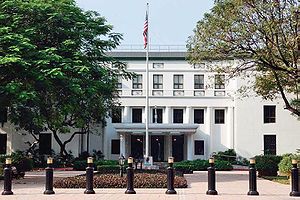
Back Cancelleria Catalan Kancelario Esperanto Cancillería Spanish चांसरी Hindi Kanselari ID Kancelaria Albanian


A chancery is the principal office that houses a diplomatic mission or an embassy.[1] This often includes the associated building and the site.[2] The building can house one or several different nations' missions. The term derives from chancery or chancellery, the office of a chancellor. Some nations title the head of foreign affairs a chancellor, and 'chancery' eventually became a common referent to the main building of an embassy.
The building of a chancery is often erroneously referred to as an embassy. The term technically refers to the ambassador's residence and not their office. Among diplomats the terms "embassy residence" and "embassy office" is used to distinguish between the ambassador's residence and the chancery.[1] In some cases, an ambassador's residence and the business office is located in the same building.[3]
There is evidence of the existence of chanceries throughout history, playing a key role in the facilitation of diplomacy and bilateralism.[4] Chanceries have persisted into the modern age and still play a key role in the formation of foreign relations and maintenance of diplomacy.[5] The function of a chancery includes facilitating communication between sovereign states, upholding foreign policy, opening cultural connections and exchange as well as many other functions.[5] Chanceries also have other uses which include providing diplomatic asylum to those seeking it as seen in the cases of Julian Assange and Chen Guangcheng.[6]
Chanceries are said to be the interaction of diplomacy and architecture with the design of buildings heavily thought-upon.[7] The characteristics of a chancery building, and its location is well-considered in order to achieve national interests. From the exterior appearance to interior design, each play a role in the diplomacy that takes place within its walls. The features of a chancery are also crucial in ensuring that it can withstand attacks and keep its occupants safe and secure.[8] Many precautions are taken to keep the chancery secure.
When countries do not have a diplomatic relationship, and no chancery is established, there is often a disguised embassy in another country instead.[9] This is also known as a de facto embassy.
A large establishment of chanceries is the International Chancery Center (ICC) which is the first of its kind. This establishment is 47 acres of land in North-West Washington, D.C., US which is specifically allocated for chanceries.
- ^ a b "Glossary of Diplomatic Terms". eDiplomat. Retrieved 22 September 2021.
- ^ "What is a Foreign Mission /Chancery?". U.S. Department of State. Office of Website Management, Bureau of Public Affairs. Retrieved 22 September 2021.
- ^ De Maeyer, Bram; Floré, Fredie; Morel, Anne-Françoise (2021). "Architecture as Diplomatic Instrument? The Multi-Layered Meaning of the Belgian Embassy in New Delhi (1947–83)". Architectural Histories. 9 (1). doi:10.5334/ah.496. ISSN 2050-5833. S2CID 241630910.
- ^ Black, J (2010). A History of Diplomacy. London, UK: Reaktion Books.
- ^ a b "A diplomatic necessity: Why embassies persist in the digital age". www.lowyinstitute.org. Retrieved 2022-05-13.
- ^ Den Heijer, Maarten (2013-05-03). "Diplomatic Asylum and the Assange Case". Leiden Journal of International Law. 26 (2): 399–425. doi:10.1017/s0922156513000095. ISSN 0922-1565. S2CID 232390183.
- ^ Loeffler, J. (1998). Architecture of Diplomacy: Building America's Embassies. New York, NY: Princeton Architectural Press.
- ^ Cite error: The named reference
:6was invoked but never defined (see the help page). - ^ Berridge, G (2015). Diplomacy. London, UK: Palgrave Macmillan. pp. 229–240.
© MMXXIII Rich X Search. We shall prevail. All rights reserved. Rich X Search